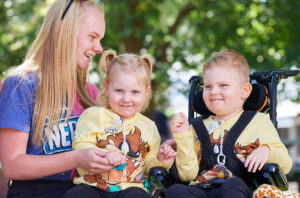
Setting your child’s NDIS goals
Your child’s NDIS plan is based on the goals you and your child hope to achieve in the next year or two, and in the future.
Setting goals
Goal setting helps you think about how your child’s NDIS plan will best support their development. When you meet with the NDIS or with your Early Childhood Partner or Local Area Coordinator (LAC) you will be asked about your child’s short and long-term goals. Goals will depend on your child’s abilities, development, age and interests.
The NDIS says that you can have as many goals as you’d like but it’s often best to focus on three or four short-term and two long-term goals, especially in the early years. Try to use goals that are broad in nature. This gives therapists and other members of your child’s team more flexibility to work on areas that require the most focus throughout the plan.
For example, if your child finds it challenging to hold a pencil, they may also find it challenging to fasten buttons. Strengthening your child’s fine motor skills (hands) will become the focus of the goal, rather than just holding a pencil. That way, therapists can work with your child to improve all fine motor skills.
The goals you develop can relate to your child’s physical, social, or emotional development as well as their mental health and well-being. You can ask your child’s therapists and other people who know and support your child to help identify meaningful goals and the supports needed to achieve them.
Goals in the early years
It can be challenging to set goals in the early years as there are many things still to learn about your child’s strengths and needs. Your Early Childhood Partner or LAC can help you to write your child’s goals using the information you, your child’s paediatrician, therapists, maternal child health nurse, or educators have provided.
For each goal there will be a section titled ‘How I will achieve this goal’. This is space to give more specific guidance to therapists.
Examples of early childhood goals
1. Max will further improve his physical development to independently participate in gross and fine motor activities.
How I will achieve this goal: Max will be supported to further improve his gross and fine motor skills. This includes strengthening his core, independently walking, jumping forward with two feet landing together, sitting for longer periods of time, holding a pencil in a tripod grasp, independently fastening buttons and zips, holding a knife and fork, placing puzzle pieces into a form board, and using a pincer grip to independently participate in activities at home and in his community.
2. Ella will further her cognitive development to improve her attention, processing, and understanding.
How I will achieve this goal: Ella will be supported to further her cognitive development, including improving her attention, processing, comprehension, memory, and problem-solving skills, understanding cause and effect, making improved decisions, recognising patterns, and understanding more complex concepts, to further her life-long learning skills.
3. Abdul will further improve his speech and language skills to better communicate with his family, peers, and community.
How I will achieve this goal: Abdul will be supported to further his speech and language, including improving his sounds, vocabulary, and sentence structure, using more complex words, requesting items, giving items on request, using gestures, understanding instructions, and gaining attention from those around him, to independently communicate with his family, friends, peers, and community.
Short-term goals for older children
Where possible, involve your child in selecting goals. As your child becomes older, goals can then be expressed using “I”.
Short-term goals can usually be achieved within 12 months. Examples of short-term goals may be:
- I want to improve my daily living skills to live as safely and independently as possible in a house near my parents, now and in the future
- I want to develop my coping skills to manage my sensory needs and high levels of anxiety
- I want to have opportunities to improve my ability to speak clearly and be understood
- I want to be able to regulate my emotions so that I can make friends and play with my siblings
- I want to improve my muscle strength and co-ordination so that I can play sport at school and on the weekend
- I want to learn how to organise my belongings so that I can find them more easily and stay calm
- I want to increase my confidence to try new things so that I can go to new places and enjoy new activities without becoming overwhelmed
- I want to be more independent in my eating, minimizing choking risks, and have better hand control when I use cutlery
Once you’ve chosen some short and long-term goals, you will need to get good evidence for the NDIS supports your child will need to achieve them.
Examples of longer-term goals
Longer-term goals may take years to achieve but you can break them down into smaller steps and short-term goals. Examples of medium to long-term goals might include:
- I want to improve my daily living skills to live as safely and independently as possible in a house near my parents, now and in the future
- I want opportunities to fully participate in the community like my peers, independent of my parents
- I want to develop my social and communication skills to make friends and to participate in community activities, including volunteering or working
- I want to maintain and improve my physical health and well-being, with increased physical exercise
Once you’ve chosen some short and long-term goals, it’s best to have reports from your child’s therapists stating how these goals will be achieved and what supports will be needed.
Useful links
How do you set the goals in your plan
Early childhood pre-planning guide



